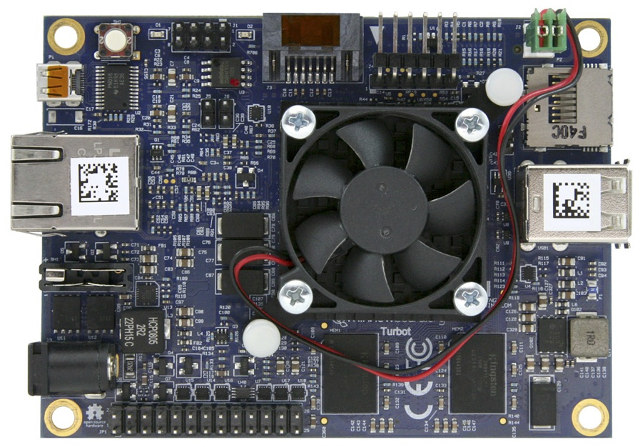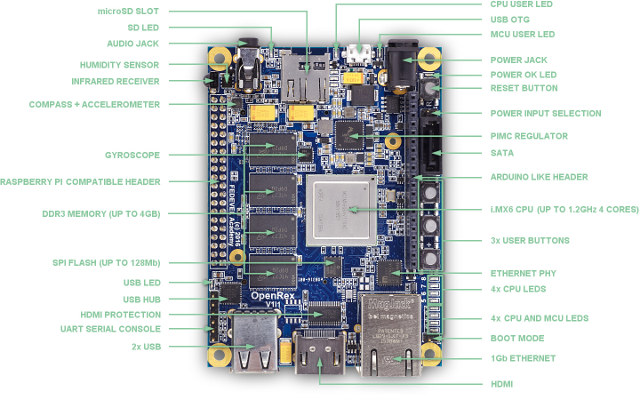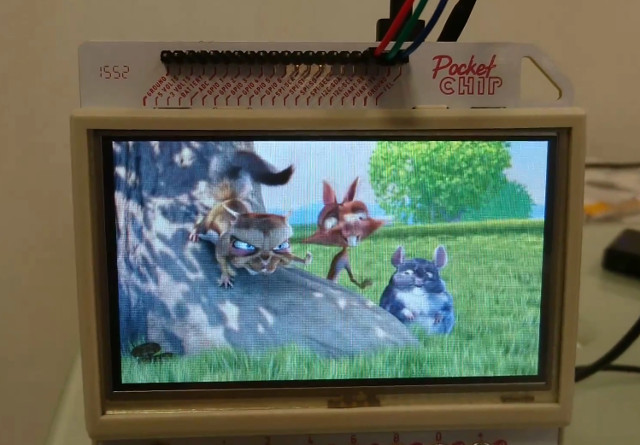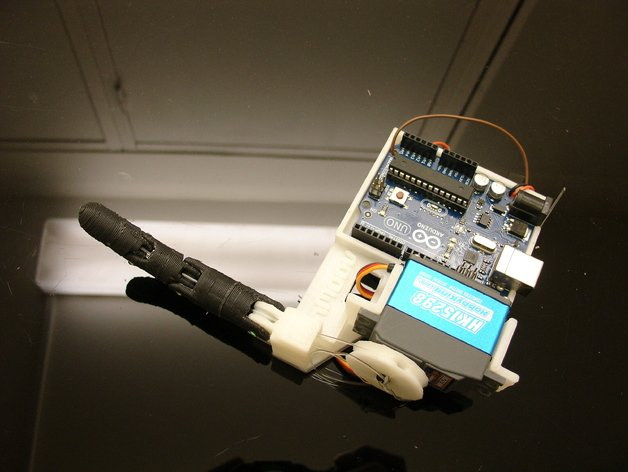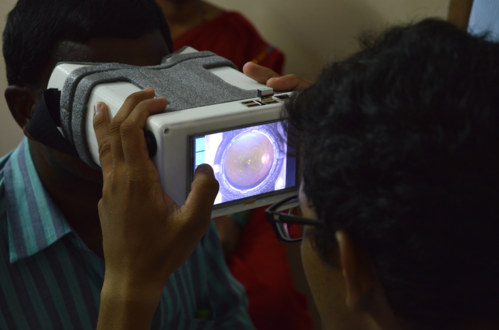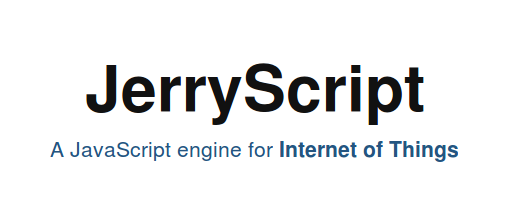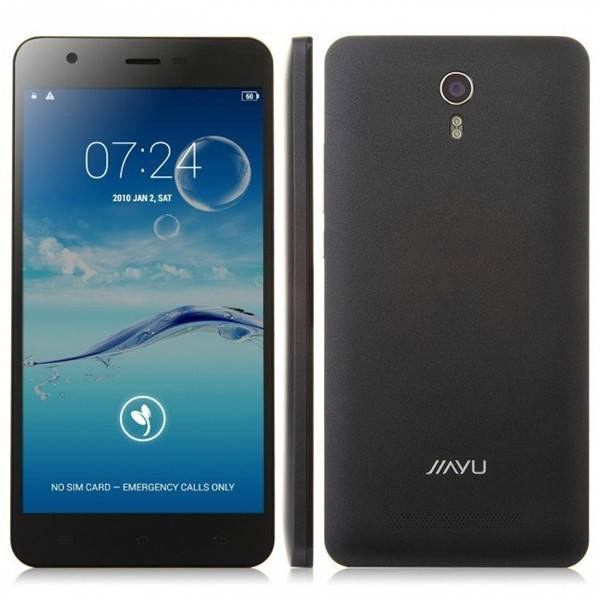MinnowBoard Turbot open source hardware SBC was released in 2015 with an Intel Atom E3826 dual core Bay Trail-I processor, 2GB RAM, SATA and Gigabit Ethernet support, and a new version – MinnowBoard Turbot Quad – with a more powerful quad core processor, an heatsink and fan, and better Ethernet connectivity will be launched in December. MinnowBoard Turbot Quad “MBT-4210” board specifications: SoC – Intel Atom E3845 quad core Bay Trail-I processor @ 1.92 GHz with Intel HD graphics @ 542 / 792 MHz (10W TDP) System Memory – 2GB DDR3L 1067 MT/s (Soldered) Storage – 1x SATA2 3Gbs, 1x micro SD card slot, , 8 MB SPI Flash for firmware (Tianocore UEFI, Coreboot, SeaBIOS) Video & Audio Output – 1x micro HDMI connector Connectivity – 10/100/1000M Ethernet RJ-45 connector (Intel i211 instead of Realtek NIC on first board) USB – 1x USB 3.0 host, 1x USB 2.0 host Debugging […]
OpenRex Open Source Hardware NXP i.MX6 Board Launched for 199 Euros and Up
OpenRex is an open source hardware board powered by NXP i.MX6 Cortex A9 processor designed by Fedevel for their hardware design course, and manufactured by Voipac, both companies based on Slovakia. The schematics, PCB layout, gerber files and other manufacturing files were released in February, but the company has only started selling the board a few days ago with OpenRex Basic SBC and OpenRex Max SBC boards. OpenRex Basic and Max boards specifications: SoC OpenRex Basic – NXP i.MX 6Solo single core Cortex A9 processor @ 1 GHz with 2D and 3D GPU OpenRex Max – NXP i.MX 6Quad quad core Cortex A9 processor @ 1 GHz with 2D and 3D GPU MCU – NXP LPC1345FHN33 ARM Cortex-M3 micro-controller @ 72 MHz System Memory Basic – 512 MB DDR3-1066 (400MHz) Max – 2GB DDR3-1066 (533 MHz) Storage Basic – micro SD slot, 1x 2Kbit I2C EEPROM, 1x 32Mbit SPI flash Max […]
C.H.I.P Board and Allwinner A13/R8 SoCs To Get VPU Support in Linux Mainline
Allwinner has mixed relationships with open source communities such as Kodi, especially due to issues with its closed-source CedarX VPU drivers, and some GPL violations. However to address the former, linux-sunxi community has been working on open source Cedrus library for the video processor unit on Allwinner processors, that’s been successfully tested on boards such as Orange Pi One. Free Electrons has gone further, as they’ve made sure Cedrus now works with Linux mainline kernel, currently Linux 4.8, and tested it on Allwinner R8 based Pocket CHIP. The work has been done by Florent Revest, a 19 years old intern at the company, who delivered a new sunxi-cedrus driver, a Video4Linux (V4L2) memory-to-memory decoder kernel driver, and corresponding VA-API backend, with the implementations currently available on Github here and there respectively. Currently only MPEG2 and MPEG4 are working, but adding other codecs such as H.264, and video encoding is possible […]
Learn the Basics of Humanoid Robots with InMoov Finger Starter Kit
In a not so distant future, most humans will live off their government provided basic income, relaxing and drinking their robot brewed, drone delivered beer or soda, opened and served by their humanoid robot maid. Well, maybe… In the meantime, it might be interesting to learn how to make humanoid robots such as InMoov, but since it’s quite complicated, it might be better to start small… with a single finger. That’s exactly what InMoov Finger Starter Kit offers you to do in order to understand the basics principles of the complete robot. The kit includes: 1x 3D printed base support in ABS 3D printed finger parts in ABS 1 meter braided 200 LB tendon 1x 5cm filament for peg/pin use to assemble finger joints 1x wheel horn adapter (Servo Pulley) 4x screws to fix the servo to the base support. You’ll also need to provide your own Arduino Uno (or […]
Project OWL Open Source Hardware Ophthalmoscope is 25 Times Cheaper than Commercial Products
Medical grade equipments are usually very expensive, partly because of their complexity, but also because of certifications, legal reasons, and low manufacturing volumes. That’s where open source hardware can make a big difference, and there has been several open source hardware prosthetic hands or arms such as Openbionics hand, but Ebin Philip and his team has tackled another issue with Project OWL, an open indirect ophthalmoscope (OIO) designed for screening retinal diseases, which normally costs between $10,000 to $25,000, but their open source hardware design can be put together for about $400. The design features a Raspberry Pi 2 board connected to a WaveShare 5″ Touchscreen LCD, a Raspberry Pi Pi IR Camera (M12 lens mount) with 16mm FL M12 lens, a 3 Watt Luxeon LED, two 50x50mm mirrors, a linear polarizer sheet, a 20 Dioptre disposable lens, and various passive components. While the Raspberry Pi board is not open […]
Samsung JerryScript is a Lightweight Open Source JavaScript Engine for the Internet of Things
In the old days, micro-controller programming was all done in assembly or C, but in recent years higher level languages, included interpreted ones such as Python and JavaScript, have made their ways into MCUs with projects such as MicroPython or Espruino (JS) often running on STMicro STM32 ARM Cortex M micro-controllers, but also other platforms such as ESP8266. As I browsed through the Embedded Linux Conference Europe 2016 schedule, I discovered that Samsung worked on it own implementation of a JavaScript engine for the Internet of Things: JerryScript. It is a full implementation of ECMAScript 5.1 standard written in C that can run on micro-controllers with less than 64KB RAM, and less than 200KB storage (160KB footprint with ARM Thumb-2 compilation). JerryScript is comprised of two main components: Parser and Virtual Machine (VM), with the parser performing translation of input ECMAScript application into byte-code than is then executed by the Virtual […]
Embedded Linux Conference & IoT Summit Europe 2016 Schedule
Embedded Linux Conference & IoT summit 2016 first took place in the US in April, but the events are now also scheduled in Europe on October 11 – 13 in Berlin, Germany, and the schedule has now been published. Even if you are no going to attend, it’s always interesting to find out more about the topic covered in that type of events, so I had a look, and created my own virtual schedule with some of the sessions. Tuesday, October 11 10:40 – 11:30 – JerryScript: An Ultra-lightweight JavaScript Engine for the Internet of Things – Tilmann Scheller, Samsung Electronics JerryScript is a lightweight JavaScript engine designed to bring the success of JavaScript to small IoT devices like lamps, thermometers, switches and sensors. This class of devices tends to use resource-constrained microcontrollers which are too small to fit a large JavaScript engine like V8 or JavaScriptCore. JerryScript is heavily […]
Jiayu S3 and S3 Plus Smartphones Get Android 6.0 Firmware Releases with Source Code
Jiayu S3 and S3 Plus are your typical Android smartphones powered by Mediatek MT6752/MT6753 octa core Cortex A53 processor with 3GB RAM, 16GB flash, and a 5.5″ touch screen display. The news here is that Jiayu Germany (a reseller, not the manufacturer), and Team M.A.D (Mediatek Android Developers) comprised of XDA members, have releasing three custom ROMs based on Android 6.0.1 for the smartphone: Cyanogenmod13, Paranoid Android (AOSPA) and AICP (Android Ice Cold Project), which contrast with my Iocean MT6752 smartphone still stuck on Android 4.4.4. I’ll reproduce the technical specifications of Jiayu S3+ phone for reference: SoC- Mediatek MT6753 Octa-core 64-bit ARM Cortex A53 processor @ 1.3 GHz, with ARM Mali-T720 GPU System Memory – 3GB RAM Storage – 16 GB eMMC + micro SD slot up to 64GB Display – 5.5” IPS capacitive touchscreen display; 1920×1080 resolution Connectivity – 802.11 b/g/n/ac Wi-Fi , Bluetooth 4.0, GPS / A-GPS, FM Radio Cellular […]


